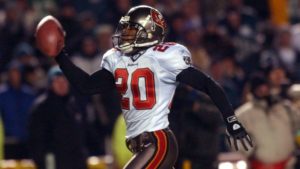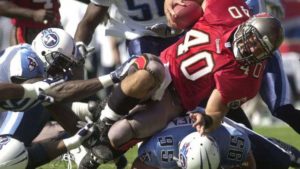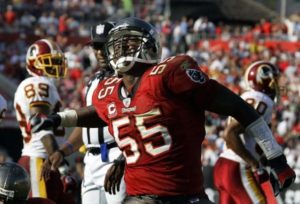In 1997, the Tampa Bay Buccaneers completely changed their image. Gone were the orange uniforms and gone was the image of “Bucco Bruce.” The Buccaneers were entering the late 90s with an attitude problem and put the rest of the NFL in their crosshairs.
When 1998 rolled around, the Bucs were also playing in a new stadium. Raymond James Stadium opened on September 20th, 1998. With their new home, the Bucs also had a fresh set piece. A pirate ship that rose from the northern end zone.
Instead of dawning their original jerseys, a uniform that made them stand out in the NFL for over 20 years, the Bucs switched to red and pewter with orange trim on the numbers and pants. Their new logo became a symbol of intimidation, and it screamed, “Fear us.”
A take on the classic pirate flag, however, the Bucs put their own spin on it. A red flag with a skull with two swords crossing, and a football.
These jerseys defined the Buccaneers for nearly 20 years and are loved by fans. A great offense feeding off a terrifying defense set the tone for the Bucs and their “Glory Days.” The players that sported these jerseys are some of the best to play in Tampa.
Ronde Barber (1997-2012), DB

The Buccaneers selected Ronde Barber, brother of running back Tiki Barber, in the third round of the 1997 draft. Although his rookie year started off slow, Barber proved himself in 1998 with two interceptions and three sacks.
As the years went on, Barber was one of the best players in the NFL. In 2001, he had one of his best seasons, bringing in 10 interceptions and 5.5 sacks. Barber also saw his first Pro Bowl and First-Team All-Pro selections.
In 2002, the Buccaneers played the Philadelphia Eagles in the NFC championship game. The Bucs won the game 27-10, sending them to their first Super Bowl. Barber was an instrumental part of that victory.
Barber’s career after the Super Bowl win was just as good, appearing in four more Pro Bowls. He was also chosen to two more First-Team All-Pro honors.
Ronde Barber retired after the 2012 season with a career line of 47 interceptions with 923 yards and eight touchdowns. His name is forever remembered in Buccaneers’ history and was recently added to the “Ring of Honor” in 2019.
Mike Alstott (1996-2006), RB

Tampa Bay selected Mike Alstott in the ’96 draft in the second round. He had a productive rookie campaign rushing for 377 yards with three touchdowns. In 1997, Alstott went to his first Pro Bowl. That same year, he was given the honor of First-Team All-Pro.
His best season with the Buccaneers was in 1999 where he rushed for 949 yards and seven touchdowns. His receiving stats were also incredible that year, reigning in 29 receptions, 239 yards, and two touchdowns.
Like Ronde Barber, Alstott’s performance in the 2002 playoffs was key to the Bucs winning the Super Bowl. Alstott played all of his 10 years in Tampa Bay and made it to five more Pro Bowls and selected as a First-Team All-Pro two more times.
Mike Alstott retired after the 2006 season with a stat line of 5,088 yards and 58 touchdowns. Although he’s not a Hall of Famer, his name hangs high in the Buccaneers’ Ring of Honor.
Warren Sapp (1995-2003), DT

In the first round of the 1995 draft, the Buccaneers selected Warren Sapp out of the University of Miami. Sapp’s first two seasons didn’t look too pretty, but in 1997, he found his footing and went to his first Pro Bowl. His career would soon become a legendary one.
Sapp went to six more Pro Bowls in a row, and in the early 2000s was First-Team All-Pro four years in a row. His best season in Tampa Bay was in 2000 where he had a staggering 16.5 sacks and 43 solo tackles. Just the year prior, Sapp had 12.5 sacks and 27 solo tackles.
Sapp helped solidify the Bucs defense of the late ‘90’s early 2000s. After his years with Tampa, he played with the Oakland Raiders in 2004. He eventually retired in 2007. In 2013, Sapp was inducted into the Pro Football Hall of Fame.
Along with Alstott and Barber, his name is ingrained in the Ring of Honor. His number 99 is also retired by the Bucs. Sapp retired with an outstanding 96.5 sacks and 440 solo tackles.
John Lynch (1993-2007), DB

Although John Lynch played in the Creamsicle, his best years were in the red and pewter. Drafted by the Bucs out of Stanford in 1993, Lynch brought an unrivaled leadership to the Buccaneers. In 1997, Lynch was selected to his first Pro Bowl and would be given the recognition eight more times in his career.
Lynch’s defining year in Tampa Bay was the 2000 season, where he had three interceptions, 43 yards, one sack, and 56 solo tackles. The years following were equally kind to Lynch. He, along with Sapp and Barber, made the Buccaneers’ defense a force. His number 47 is retired by the Bucs and having his name in the Ring of Honor.
After his years in Tampa, Lynch went to play with the Denver Broncos where his name and number are also retired. He also went to four Pro Bowls as Bronco. He retired after the 2007 season. His career numbers were 26 interceptions and 204 yards.
Derrick Brooks (1995-2008), LB

Likewise, to Sapp, Derrick Brooks was drafted in the same round of the same year, 1995. Derrick Brooks was drafted out of Florida State University and is widely regarded as the best Buccaneer of all time. Spending all 14 seasons in Tampa Bay, Brooks helped define what the Buccaneers defense could do.
With 11 Pro Bowls and five First-Team All-Pro honors under his belt, Brooks’ best year in red and pewter was in 2002. Brooks boasted five interceptions for 218 yards, three touchdowns, and 88 solo tackles. He also won the Walter Payton “Man of the Year” Award in 2000.
Brooks was inducted into the Pro Football Hall of Fame in 2014. Besides all the names on this list, his name is forever remembered in the Ring of Honor. Brooks’ number 55 is also retired. His career numbers were also incredible with 25 interceptions for 530 yards, and six touchdowns.
Conclusion
The “Glory Days” brought the Buccaneers not only their first Super Bowl but also one of the best defenses in NFL history. Since the rebranding in 1997, fans still look at this team from the late 1990s into the early 2000s with great joy.
Past players like Lee Roy Selmon set the groundwork for what the Bucs could be. The Bucs in their “Glory Days” redefined it and gave themselves an edge.










